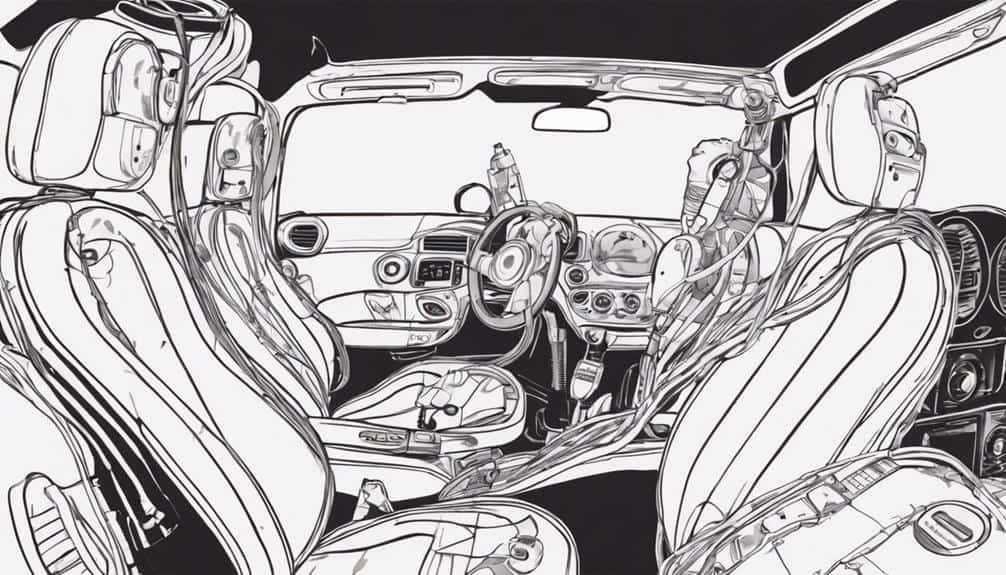If the radio in your Mini Cooper isn't working, it could be due to common issues like blown fuses, faulty wiring, or a malfunctioning amplifier. Check the radio fuse for damage, inspect wiring connections for current flow, and troubleshoot faulty buttons or controls. Address speaker sound problems, volume control issues, and consider testing and replacing the head unit if needed. Understanding steering wheel button failures and utilizing diagnostic tools can also help diagnose and resolve radio system malfunctions. Get started with these steps to get your Mini Cooper radio up and running again.
Common Mini Cooper Radio Issues
If your Mini Cooper radio is experiencing issues, it could be due to various common problems like blown fuses, faulty wiring, or a malfunctioning amplifier. One frequent issue is a blown fuse, which can disrupt power to the radio and prevent it from functioning correctly.
The head unit, or the radio itself, may encounter problems such as loose connections or internal issues, leading to sound distortions or no audio output. Faulty wiring can also cause issues, disrupting the flow of electricity and affecting the radio's performance.
In some cases, a malfunctioning amplifier could be the culprit behind sound quality problems like low volume or distorted audio. Understanding these common Mini Cooper radio issues is essential for diagnosing and resolving any audio system malfunctions efficiently. By inspecting the fuses, connections, and components like the head unit, you can pinpoint the root cause of the problem and take appropriate steps to address it effectively.
Checking the Radio Fuse
To diagnose radio issues in your Mini Cooper, start by checking the radio fuse for any signs of damage or wear. A blown fuse is a common culprit for a non-working radio and can protect the electronic components from power surges that may harm the radio. If your stereo is completely out, it might indicate a blown radio fuse.
In modern Mini Cooper audio setups, there are multiple fuses that play an important role, so it's vital to inspect each one carefully. When replacing a blown fuse, make sure that you use the correct amperage rating to prevent further damage to the radio.
Locate the fuse box in your Mini Cooper, usually found in the engine compartment or interior dashboard. Identify the radio fuse by consulting your owner's manual or the fuse box diagram. Carefully remove the radio fuse and check for any signs of a break or discoloration, indicating a blown fuse. If the fuse is indeed blown, replace it with a new one of the same amperage rating to restore functionality to your Mini Cooper's radio system.
Assessing Radio Wiring Connections
Examine the wiring connections of your Mini Cooper's radio to guarantee proper current flow and troubleshoot any potential issues effectively. Start by inspecting the wiring harness that connects to the back of the radio unit. Make sure that the harness is securely plugged in and that there are no loose or damaged wires. Check for any signs of wear or corrosion that could be impacting the connection.
Moreover, it's essential to check the fuse box related to the radio system. Locate the fuse that corresponds to the radio and verify if it's intact. A blown fuse can disrupt the power supply to the radio, leading to malfunctions. If the fuse is blown, replace it with a new one of the correct amperage to restore power to the radio.
Troubleshooting Faulty Radio Buttons
When troubleshooting faulty radio buttons, closely examine for physical damage or wear on the button surfaces. Check if the buttons are sticking or not responding when pressed. Use a multimeter to test the continuity of the button circuit and confirm proper electrical flow. Look for any loose connections or corrosion on the button contacts that could be causing the issue. Verify if the radio responds to other controls but not the specific buttons in question. If all troubleshooting steps fail to resolve the problem, consider replacing the button panel to restore functionality.
If the buttons show signs of wear or physical damage, replacing them may be necessary to guarantee proper functioning of the radio. Make sure that the replacement buttons are compatible with your specific radio model to avoid any compatibility issues. If the problem persists even after replacing the buttons, further inspection may be needed to diagnose any underlying issues with the radio system.
Dealing With Speaker Sound Problems
Check the speaker connections to make sure they're secure and properly plugged in.
Adjust the volume control to troubleshoot issues like low sound output or static noises.
Be sure to follow these steps to address any speaker sound problems in your Mini Cooper radio system effectively.
Speaker Connection Check
To guarantee excellent sound quality in your Mini Cooper, carefully inspect the speaker connections for any signs of loose or damaged wires that could be affecting the audio output.
Confirm that the speaker wires are securely connected to both the head unit and the speakers. Look out for visible signs of wear or corrosion on the speaker connections, as these could be causing stereo problems.
Test each speaker individually to determine if the issue lies with a specific speaker or the overall connection. If needed, consider using a multimeter to check for continuity in the speaker wires to ensure proper functionality.
Volume Control Adjustment
For ideal sound quality in your Mini Cooper, fine-tune the volume control settings on your stereo to troubleshoot any speaker sound problems effectively. Adjust the volume to make sure it is not too low or high, as extreme settings can impact sound clarity. Use the radio head unit to control the volume and test different levels to find the best setting. Balancing the volume can help identify if specific speakers are not working correctly. Additionally, check the fade settings to make certain sound is evenly distributed between speakers. By adjusting these controls, you can work towards resolving any sound issues and enjoy a superior audio experience in your Mini Cooper.
| Volume Control Adjustment | Actions to Take | Benefits | Additional Tips |
|---|---|---|---|
| Check Volume Levels | Adjust volume settings on the radio head unit. | Improved sound clarity and volume control. | Avoid sudden volume changes to protect speakers. |
| Test Different Levels | Test various volume levels to find the best setting. | Identify the ideal volume for your listening preference. | Use preset volume levels for convenience. |
| Balance and Fade Setting | Fine-tune the balance and fade settings for even sound output. | Ensure sound is evenly distributed across all speakers. | Make slight adjustments for a personalized sound experience. |
Addressing Volume Control Issues
When experiencing low volume or static noise from your Mini Cooper's stereo, a recommended troubleshooting step involves disconnecting the battery for 15-20 minutes to reset the system. This can help resolve minor issues with the stereo head unit and amplifier.
To address volume control problems systematically, follow these steps:
- Disconnect and Reconnect Battery: After the reset, reconnect the battery and check if the volume issue persists. This simple step can often recalibrate the system and fix minor glitches.
- Check for Amplifier Issues: If you experience loud volume noises or distorted sound, it may indicate a problem with the amplifier. Consider replacing the amplifier as outlined in the troubleshooting process.
- Systematic Troubleshooting: Address volume control problems methodically to identify the root cause. Consider voltage fluctuations and power supply stability when diagnosing and repairing the stereo system.
Diagnosing Radio Module Problems
Examine the wiring and connectors behind the radio head unit to check for potential radio module problems. Begin by inspecting the stereo system's connections for any loose or damaged wiring. Confirm that all connectors are securely plugged in and free of corrosion. If the wiring appears intact, proceed to testing the head unit itself.
Conduct a continuity test on the FM button to identify any button failures that may be affecting the radio's functionality. Utilize a scanner to confirm that input signals from the buttons are being properly received by the radio module.
Also, remember to check the mini coax antenna connections for any faults that could be impacting the radio reception. If internal malfunctions or wiring issues are identified within the radio module, consider replacing the head unit to resolve the issue effectively.
Understanding Steering Wheel Button Failure
After diagnosing radio module problems in your Mini Cooper, understanding steering wheel button failure is essential for maintaining proper control over your audio system. When your steering wheel buttons fail, it can disrupt your ability to interact with the radio effectively. Here are some key points to help you grasp steering wheel button failure:
- Wiring Connections: Issues with the wiring connections in your Mini Cooper can lead to steering wheel button failure, impacting your control over radio functions such as changing stations or adjusting volume.
- Functionality Impact: Faulty steering wheel buttons may result in a lack of response or incorrect functionality when attempting to control the radio, affecting your overall driving experience.
- Symptoms: Common signs of steering wheel button failure include the inability to adjust volume, change radio stations, or activate voice commands, indicating a potential issue that needs attention.
Understanding these aspects can aid in identifying and addressing steering wheel button failures promptly, ensuring continued smooth operation of your vehicle's audio system.
Using Diagnostic Tools for Radio System
To effectively diagnose radio system issues in your MINI Cooper S, using diagnostic scan tools is vital for pinpointing communication faults and guaranteeing a thorough assessment of the module's functionality. These tools play a critical role in identifying and checking for stored faults in the system, allowing for a detailed diagnosis of radio problems. Accessing the ABS module through diagnostic scan tools can provide further insights into the radio system's functionality, aiding in a more thorough troubleshooting process. It's recommended to seek mechanic assistance when using diagnostic scan tools for troubleshooting radio issues in your MINI Cooper S to make sure proper handling and interpretation of the data retrieved.
Furthermore, diagnostic scan tools enable the monitoring of live values related to circuits, which can help in pinpointing specific issues affecting the radio system. By utilizing these tools effectively, you can streamline the diagnostic process and expedite the resolution of any radio-related problems in your MINI Cooper S.
Conclusion
If the radio in your Mini Cooper isn't working, don't worry.
By examining the fuse, evaluating wiring connections, troubleshooting buttons, dealing with sound issues, and diagnosing module problems, you can get to the root of the issue.
Remember, like untangling a knot, patience and methodical steps will help you uncover the problem and get your radio back up and running smoothly.


